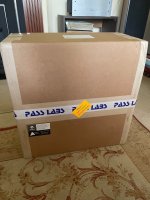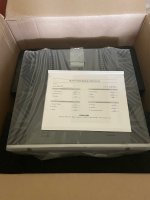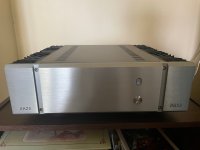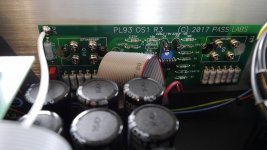forgive me, Papa was busy in time of thread opening, or I would ask him to write clear presentation ...... he's Master of Clarity, me just limping in his footsteps even in that area
so, I did my best to present it ...... anyhow - same basic amp, having balanced or SE input by user choice, in 3 iterations of OS:
1.pure MOS, called simply Babelfish XA252
2.upper mosfet connected in Schade arrangement, so Poor Man's SIT emulation, called simply Babelfish XA252 SET (yup, codyt got it right, Schade Enhanced Thingie, or 300B Fetishists can eat my liver)
3.upper mosfet exchanged with SIT, so Rich Man SIT amp, called simply Babelfish XA252 SIT
again, amp is having balanced input, whatever arrangement of OS is, and you can ground negative bal input, getting SE (RCA) input
so, I did my best to present it ...... anyhow - same basic amp, having balanced or SE input by user choice, in 3 iterations of OS:
1.pure MOS, called simply Babelfish XA252
2.upper mosfet connected in Schade arrangement, so Poor Man's SIT emulation, called simply Babelfish XA252 SET (yup, codyt got it right, Schade Enhanced Thingie, or 300B Fetishists can eat my liver)
3.upper mosfet exchanged with SIT, so Rich Man SIT amp, called simply Babelfish XA252 SIT
again, amp is having balanced input, whatever arrangement of OS is, and you can ground negative bal input, getting SE (RCA) input
That is very enlightening, and I will use it as a jumping off point for further research. You say rich man SIT. Do you mean also to imply better than SET?forgive me, Papa was busy in time of thread opening, or I would ask him to write clear presentation ...... he's Master of Clarity, me just limping in his footsteps even in that area
so, I did my best to present it ...... anyhow - same basic amp, having balanced or SE input by user choice, in 3 iterations of OS:
1.pure MOS, called simply Babelfish XA252
2.upper mosfet connected in Schade arrangement, so Poor Man's SIT emulation, called simply Babelfish XA252 SET (yup, codyt got it right, Schade Enhanced Thingie, or 300B Fetishists can eat my liver)
3.upper mosfet exchanged with SIT, so Rich Man SIT amp, called simply Babelfish XA252 SIT
again, amp is having balanced input, whatever arrangement of OS is, and you can ground negative bal input, getting SE (RCA) input
any of big ones - THF51, 2SK180, 2SK182
heck, you can certainly use 2SK77 or 2SK77B too, if you have it
I believe even puny 2SK2087C will do, though that one still not confirmed to endure 60W+ of dissipation
with Keratherm 86/82, I believe it will outlive Mighty Moi
heck, you can certainly use 2SK77 or 2SK77B too, if you have it
I believe even puny 2SK2087C will do, though that one still not confirmed to endure 60W+ of dissipation
with Keratherm 86/82, I believe it will outlive Mighty Moi
Very, very jealous! Nice amp.So ... while we are waiting, I thought ... what might be really helpful is a reference comparison instrument ...
View attachment 1088822View attachment 1088824View attachment 1088823
And in any case ... NP has been so unbelievably supportive ... we should always support those who support us 😉
Russellc
<Oneminde has entered the chat> 😉
As to my reason for being here: I was going to build myself a version of the GamuT D200i which also feature some pucks in the OS, and the pucks was the main reason for me wanting to build the D200i. But faith would have it so that some time passed and I have yet to build this amplifier... but, after a brief conversation with its creator Michael Edinger, I have decided not to move forward with that amp. There is no reason since the brilliant Babelfish XA252 exist and both SE & SET exist with the US or differential in the planning stages. Because that was something I wished for regarding the D200i, a differential version of it and the whole differential comes from Allan Wrights DPA-300B amplifier. I later learned that PASS also offer differential amplifiers and that is yet another reason for me being here. That AND having the prospect of building my own amplifiers with the option of bling-bling if I want too 🙂.
But it wouldn't be in my nature to not have questions, so I do.
Q1 ---------------------------------------------------------------------------------------------------------------------------------------------------------------------
The first question is oriented around the IXYS N-chn and I sincerely have something I am wondering about, so reaching out in hopes of clarifications. Most of you guy's have decided to pair the 140N20P and 40P50P pair which I find kinda odd since PASS uses 140N30P and 40P50P pair, but beyond this fact, I want to run something buy you guy's.
Looking in the datasheet for the 40P50P we find this.
As to my reason for being here: I was going to build myself a version of the GamuT D200i which also feature some pucks in the OS, and the pucks was the main reason for me wanting to build the D200i. But faith would have it so that some time passed and I have yet to build this amplifier... but, after a brief conversation with its creator Michael Edinger, I have decided not to move forward with that amp. There is no reason since the brilliant Babelfish XA252 exist and both SE & SET exist with the US or differential in the planning stages. Because that was something I wished for regarding the D200i, a differential version of it and the whole differential comes from Allan Wrights DPA-300B amplifier. I later learned that PASS also offer differential amplifiers and that is yet another reason for me being here. That AND having the prospect of building my own amplifiers with the option of bling-bling if I want too 🙂.
But it wouldn't be in my nature to not have questions, so I do.
Q1 ---------------------------------------------------------------------------------------------------------------------------------------------------------------------
The first question is oriented around the IXYS N-chn and I sincerely have something I am wondering about, so reaching out in hopes of clarifications. Most of you guy's have decided to pair the 140N20P and 40P50P pair which I find kinda odd since PASS uses 140N30P and 40P50P pair, but beyond this fact, I want to run something buy you guy's.
Looking in the datasheet for the 40P50P we find this.
- On resistance: 230mΩ ... (a bit high, but what can you do huh)
- Ciss: 11500pF
- Coss; 1150pF
- Crss: 93pF
- Slew rate: 10 V/ns
Since this is the P-chn and we don't have many P-chn to choose from, these values are sort of the reference and ideally, the N-chn will be close. So lets look at the 140N20.
- On resistance: 18mΩ ... good.
- Ciss: 7500pF
- Coss: 1630pF
- Crss: 280pF
- Slew rate: 10 V/ns
While the Input capacitance (Ciss - gate to source) is lower for the N-chn, the remaining Output (Coss - drain to source) and Reverse Transfer Capacitance (Crss - drain to gate) is significantly lower on the P-chn.
Now lets look the 140N30P part.
Now lets look the 140N30P part.
- On resistance: 24mΩ ... (still good)
- Ciss; 14800pF
- Coss: 1830pF
- Crss: 55pF
- Slew rate: 20 V/ns.
Look at Crss... its only 55pF and thus much closer to the 93pF of the P-chn part. The reason I am addressing this is Miller Capacitance and I am going to quote Aiken amps here:
The term "Miller capacitance" is often seen when reading about guitar amplifier circuit design. It refers to the effective multiplication of the plate-to-grid capacitance in a triode tube (or transistor) by the gain of the amplifying stage.
When a tube is amplifying a signal, it has to work against the plate-to-grid capacitance, charging and discharging it as the signal changes. Because the grid is a high impedance, and doesn't sink or source any current, this charging current must be sourced or sinked through the driving source resistance of the previous stage. This forms a lowpass filter, with a corner frequency determined by the source resistance of the previous stage and the input capacitance.
The Miller capacitance effect on music usually have a frequency limiting factor as well as removing some of the micro-details and transparency we often associate with Triodes and Pentodes. If you look at them tubes, you can see the the grid-to-plate (gate-to-anode) is MUCH lower compared to FETs.
300B Triode have a Cg-a of 7,5pF while the KT88 Pentode have a Cg-a of only 2.5pF... and the later happen to have more details and resolution compared to the 300B. A drastically lower Miller capacitance. So the 55pF for the 140N30P part is actually among the better out there and better than the Vishay IRFP240 (130pF) and IRFP9240 (81pF) parts.
Ofc, they don't beat the lateral MOSFETS from Exicon which are only 10pF, but they are only 125W and 8A packages, so not really useful here.
Also, if we look at the SOA of the 140N20P and 140N30P, we can see that the 140N30P is almost identical to 40P50P.
Q: With all of the above in mind - what was the reasoning for 140N20P over 140N30P for the Babelfish version ???????
Q2 --------------------------------------------------------------------------------------------------------------------------------------------------------------------
Now that the new gain-set scheme for the XA25 is known (exist online), aka, the removal of the degeneration resistor.
Source:
https://www.aikenamps.com/index.php/what-is-miller-capacitance
http://www.exicon.info/products.php#chartlink
https://www.vishay.com/docs/91210/91210.pdf
https://www.vishay.com/docs/91239/sihfp924.pdf
Attachments
1. calculate Miller for common drain stage
1a. lack of mileage often results in obsessing with tiny details, which can be only observed after plethora of mileage; you can't even think of importance of interelectrode capacitances without context - first taking in account mode of operation ( common drain, source or gate) and then cojones of driving stage and then amount of NFB in system; you didn't even think of xconductance in your table of data, and you certainly didn't think of fact that Pa ( nor Mighty ZM) is not sharing your obsession with identical transfer characteristic of part used in adjacent OS halves ; in case that everything is damn symmetrical, I'll have much harder work to invoke 2nd as dominant
2. I have no problem with that resistor; it's there to shape THD Spectra by my wishes and it isn't in OS; name of the game was to make Square Law OS amp, not everything without any sort of degeneration
as I wrote - I had beautiful iteration of Babelfish XA25 ( distinction - no 2 on end), with handfull of tricks included, so different enough to Papa's origin ..... but I didn't even put it to power to try it for more than 2 years sitting on the shelf, simply feeling that I didn't reach sparkle I wanted to be present; this iteration gave me pleasure of having that sparkle
build something, stop obsessing with things you're not able to put in right place in Pyramid of Significance, without building and measuring and thinking what's really important
see:
without context, several lines of pure Audioophool Mythology and BS, apples and oranges......... plenty of that you can read in mindless Audio Periodicals, where majority of writers are not able to replace fuse in amp ......
I mean, let's write and read jokes here, that's healthy, and let's remember that this forum is (mostly) about belts and wheels ....... bells and whistles - best to leave those to Forums where endless talks about Synergy between components is maximum of enlightenment
aha, use either -20 or -30 as N channel, depending of your luck which one you can get; you'll not hear difference, even if you use -20 in one channel and -30 in second
that gives you common drain OS, stable enough biasing circ, cojones of drive and NFB
1a. lack of mileage often results in obsessing with tiny details, which can be only observed after plethora of mileage; you can't even think of importance of interelectrode capacitances without context - first taking in account mode of operation ( common drain, source or gate) and then cojones of driving stage and then amount of NFB in system; you didn't even think of xconductance in your table of data, and you certainly didn't think of fact that Pa ( nor Mighty ZM) is not sharing your obsession with identical transfer characteristic of part used in adjacent OS halves ; in case that everything is damn symmetrical, I'll have much harder work to invoke 2nd as dominant
2. I have no problem with that resistor; it's there to shape THD Spectra by my wishes and it isn't in OS; name of the game was to make Square Law OS amp, not everything without any sort of degeneration
as I wrote - I had beautiful iteration of Babelfish XA25 ( distinction - no 2 on end), with handfull of tricks included, so different enough to Papa's origin ..... but I didn't even put it to power to try it for more than 2 years sitting on the shelf, simply feeling that I didn't reach sparkle I wanted to be present; this iteration gave me pleasure of having that sparkle
build something, stop obsessing with things you're not able to put in right place in Pyramid of Significance, without building and measuring and thinking what's really important
see:
The Miller capacitance effect on music usually have a frequency limiting factor as well as removing some of the micro-details and transparency we often associate with Triodes and Pentodes. If you look at them tubes, you can see the the grid-to-plate (gate-to-anode) is MUCH lower compared to FETs.
300B Triode have a Cg-a of 7,5pF while the KT88 Pentode have a Cg-a of only 2.5pF... and the later happen to have more details and resolution compared to the 300B. A drastically lower Miller capacitance. So the 55pF for the 140N30P part is actually among the better out there and better than the Vishay IRFP240 (130pF) and IRFP9240 (81pF) parts.
Ofc, they don't beat the lateral MOSFETS from Exicon which are only 10pF, but they are only 125W and 8A packages, so not really useful here.
without context, several lines of pure Audioophool Mythology and BS, apples and oranges......... plenty of that you can read in mindless Audio Periodicals, where majority of writers are not able to replace fuse in amp ......
I mean, let's write and read jokes here, that's healthy, and let's remember that this forum is (mostly) about belts and wheels ....... bells and whistles - best to leave those to Forums where endless talks about Synergy between components is maximum of enlightenment
aha, use either -20 or -30 as N channel, depending of your luck which one you can get; you'll not hear difference, even if you use -20 in one channel and -30 in second
that gives you common drain OS, stable enough biasing circ, cojones of drive and NFB
Last edited:
Thanks ZM, that is good enough answers for me 🙂 I can always "bother" my own brain with component quality's etc.
I wasn't complaining at all about your interpretation, your Babelfish XA252 series is one hell of an accomplishment, beating many.. MANY .. engineers and products on the market and there is something special about a circuit that gets away with very few components and yet can maintain an equal or .. or BETTER than. While the XA25FE is the inspiration, you achieved the results on breadcrumbs and common sense (as an engineer), and that has to and should be recognized, so here it is: Officially recognized 🙂
I understand that in the end, the topology, architecture and internal communication as well as error correction matters more than "should I used this part or that part". We are ofc talking about two different things. One is always ideal since it is a theoretical one whilst the other is a real product of some specific rules. Yes, based on experience and know how... but still, components and their layout have inductive and capacitive parasitic, and so it would stand to reason that less is more...
As a closing statement: In my mind or opinion, due to only using one pair in the OS, this amplifier and its differential sibling, together with its elegant yet simple buffer and drivers stage (what else do one need?), this amplifier will probably stand the test of time, be the milestone many try an reach for to build upon. And because of that... because of it, I definitely want to give it components that stand out. As an example, foil resistors as the gate stop resistor.
And that's it.
I wasn't complaining at all about your interpretation, your Babelfish XA252 series is one hell of an accomplishment, beating many.. MANY .. engineers and products on the market and there is something special about a circuit that gets away with very few components and yet can maintain an equal or .. or BETTER than. While the XA25FE is the inspiration, you achieved the results on breadcrumbs and common sense (as an engineer), and that has to and should be recognized, so here it is: Officially recognized 🙂
I understand that in the end, the topology, architecture and internal communication as well as error correction matters more than "should I used this part or that part". We are ofc talking about two different things. One is always ideal since it is a theoretical one whilst the other is a real product of some specific rules. Yes, based on experience and know how... but still, components and their layout have inductive and capacitive parasitic, and so it would stand to reason that less is more...
As a closing statement: In my mind or opinion, due to only using one pair in the OS, this amplifier and its differential sibling, together with its elegant yet simple buffer and drivers stage (what else do one need?), this amplifier will probably stand the test of time, be the milestone many try an reach for to build upon. And because of that... because of it, I definitely want to give it components that stand out. As an example, foil resistors as the gate stop resistor.
And that's it.
A technical question. Looking at the [Babelfish XA252 - SIT pcb top render] picture, there are some rectangular areas which looks to be made up by vias only, located at the source as well as LS+ connection. What is the purpose ? .. I can see that the actual PCB have lots of holes, is it to elevate heat build-up ?
And the LS denotation, what does LS stand for ?
Are you using chassis GND as return path for NEG- speaker terminal ?
And the LS denotation, what does LS stand for ?
Are you using chassis GND as return path for NEG- speaker terminal ?
initial set of pcbs having mucho vias, way of increasing copper mass
later set of pcbs having via fields in lesser amount, just in specific location
LS , what you usually connect to output of your amp
usual way of connecting speaker is to audio GND, not chassis
later set of pcbs having via fields in lesser amount, just in specific location
LS , what you usually connect to output of your amp
usual way of connecting speaker is to audio GND, not chassis
Okay, so LS+ stand for Left Speaker + ... ? Oh, there we go... LS- next to GND on the PCB .. got it 🙂 .. Didn't see it before.
Thx for answering my questions.
Thx for answering my questions.
My goals are to build the SET and use as my daily driver and once I have my house, some time from now, complete the differential and use them for a fully active system together with PASS's / diya active crossover. But mostly looking forward to the SET which will be the first one, driven by a custom UGS MUSES preamplifier. Actually sitting and contemplating which of the PASS gain stages I should use. The contemplation is actually regarding degeneration resistors... there's a few options, but, that is for another debate 😉
🙂 ... Mouser is out of OS until the spring, so not much will happen. And besides, need to work on the preamp.
- Home
- Amplifiers
- Pass Labs
- Babelfish XA252 / Babelfish XA252 SIT / Babelfish XA252 SET




